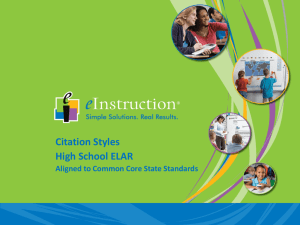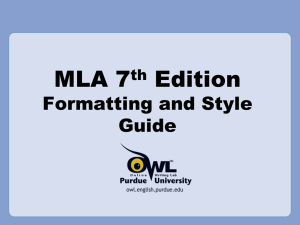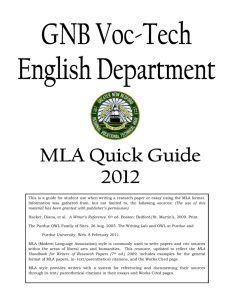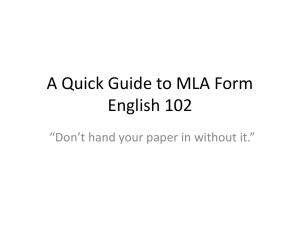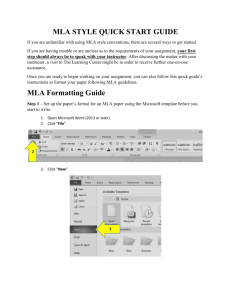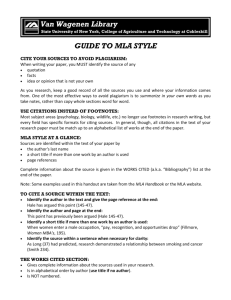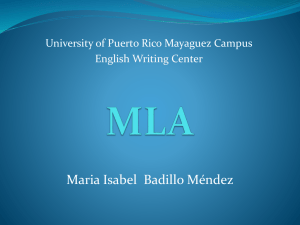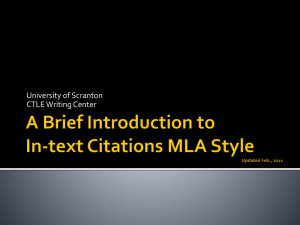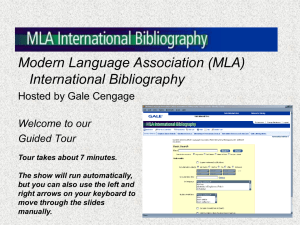MLA Citation and Documentation
advertisement
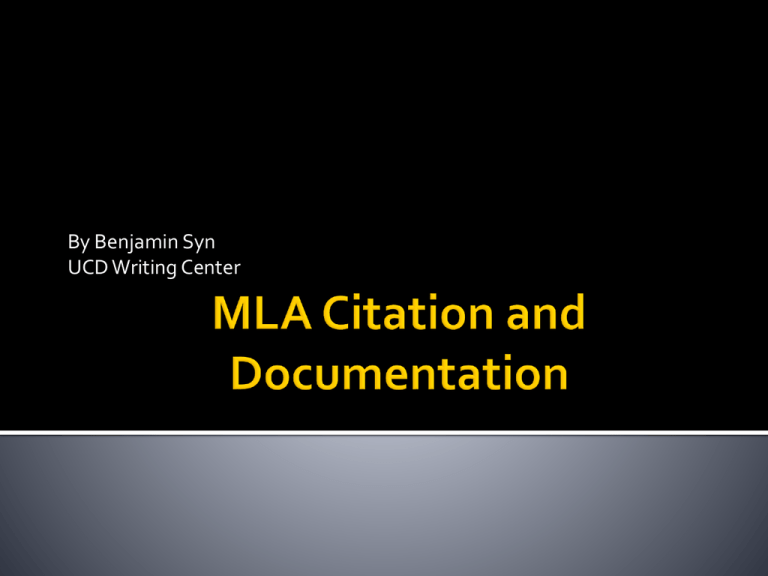
By Benjamin Syn UCD Writing Center No More Underlining! Underlining is no more. MLA now recommends italicizing titles of independently published works (books, periodicals, films, etc). No More URLs! While website entries will still include authors, article names, and website names, when available, MLA no longer requires URLs. Writers are, however, encouraged to provide a URL if the citation information does not lead readers to easily find the source. Publication Medium. Every entry receives a medium of publication marker. Most entries will be listed as Print or Web, but other possibilities include Performance, DVD, or TV. Most of these markers will appear at the end of entries; however, markers for Web sources are followed by the date of access. New Abbreviations. Many web source entries now require a publisher name, a date of publication, and/or page numbers. When no publisher name appears on the website, write N.p. for no publisher given. When sites omit a date of publication, write n.d. for no date. For online journals that appear only online (no print version) or on databases that do not provide pagination, write n. pag. for no pagination. Where things go and why Leave an exactly one inch (1”) margin: At the top At the bottom On both sides Align all text flush with the left margin There are only two exceptions to this rule: ▪ Titles (including “Works Cited”) are centered ▪ Page numbers are flush with the right margin Unless your professor says otherwise, DOUBLE-SPACE EVERYTHING. In previous versions of MLA there were parts, such as block quotations and the works cited page that had different spacing. However, under current MLA guidelines, everything needs to be double-spaced. Page Numbers • Page numbers are: • • • In the header, one-half inch from the top. Flush with the right margin Go on every page, including the first page and the Works Cited page(s). Heading Unless your professor insists on it, do not include a title page. Instead, on your first page you need to have four elements: Your name Your professor’s name The course The date the assignment is due Rules for your title: DOs: ▪ Double-space and center your title beneath the date ▪ Capitalize these words of your title: ▪ The first ▪ The last ▪ All principle words DON’Ts ▪ Italicize/underline your title and do not put quotation marks around your title (unless your title mentions the title of another work) ▪ Put a period at the end of your title ▪ Capitalize these (unless they are the first or last word): ▪ ▪ ▪ ▪ Articles Prepositions Coordinating conjunctions The to in infinitives Giving credit where it’s due Use the first page of the Samuel Greengard’s scholarly article “Censored!” to: Create a properly formatted Works Cited entry Create parenthetic citations for these quotes 1) 2) a) b) c) Samuel Greengard writes, “Many observers criticized Google for bowing to pressure from the Chinese government” (________). Several Asian nations including China and India “use Internet censorship to dominate the political dialogue” (________). Professor Andrew Lih offers, “In many countries, censorship is a deeply entrenched practice” (________). A citation can either be a paraphrase of the ideas in your own words or a direct quote from the original text. Paraphrase ▪ To paraphrase means to restate information from a source in an original way ▪ Even though you are paraphrasing, you must ALWAYS cite the source’s author Direct Quotations ▪ Retain the meaning and credibility of the original source ▪ Capture exact language that supports your point; in many instances, they capture language that is unusual, well crafted, striking, and/or memorable. Commas and periods are always placed inside the quotation mark: Modern poems, like T.S. Eliot’s “The Hollow Men,” are a pleasure to read. Exception: When using in-text citations, your comma will go outside the quotation marks and parenthetical: “The Dead,” a short story in James Joyce’s Dubliners, depicts a man coming to terms with his own mortality: “His soul had approached that regions where dwell the vast hosts of the dead” (176). When you reference any outside material, provide a citation You MUST provide a citation for any information or idea that is not your own or common knowledge Citations are: Are in parentheses Immediately after a quotation or paraphrase But before the punctuation Inside the parentheses you need two things: Author’s last name 1. ▪ ▪ 2. If a source doesn’t have a known author, use an abbreviated title If you are using several works by the same author, you will need to include the author’s name and an abbreviated title Page(s) referenced ▪ If the author is mentioned in the sentence, only the page number is in the parenthetic citation In-Text Citation Author’s name in the text (6.3) In-text Citation (MLA) Author’s name in reference (6.3) In-text Citation Citing Indirect Sources (6.4.7) Block Quote • Direct quotations that go over four lines need to be turned into block quotes: • Use a colon to introduce quote • Indent quote 1” • Omit quotation marks • The parenthetic comes after the period A list of all the sources from the text New page Double-space throughout The title “Works Cited” is centered, one inch from top Each entry is Flush with left margin ▪ Subsequent lines are indented one-half inch, which is called hanging indention Alphabetized by author’s last name ▪ Or title if author is unknown (ignoring A, An, or The) Author(s). “Article Title.” Journal Volume.Issue (Year): Page(s). Medium. Connelly, Deborah S. “To Read or Not To Read: Understanding Book Censorship.” Community & Junior College Libraries 15.2 (2009): 83-90. PDF file. Author(s). “Article Title.” Newspaper/Magazine Day Month Year: Page(s). Medium. Wines, Michael. “China: Censors Bar Mythical Creature.” New York Times 30 Mar 2009: 8. Print. Authors. Title of Book. Place of Publication: Publisher, Year of Publication. Medium. Karolides, Nicholas J., Margaret Bald, and Dawn B. Sova. 100 Banned Books: Censorship Histories of World Literature. New York: Checkmark Books, 1999. Kindle file. If you have a source with four or more authors, you can offer the first author and replace the rest with the phrase et al. (“and others”). Author. “Title of Chapter/Poem/Short Story/etc.” Title of Book. Editor. Edition. Place of Publication: Publisher, Year of Publication. Page(s). Medium. Rosenblatt, Roger. “We Are Free to Be You, Me, Stupid, and Dead.” Language Awareness. Eds. Paul Eschholz, Alfred Rosa, and Virginia Clark. 10th ed. Boston: Bedford/St. Martin’s, 2009. Print. “Entry.” Title of Reference Book. Edition. Year. Medium. “Censorship.” Oxford English Dictionary. 2nd ed. 1989. Print. Author(s). “Page.” Website. Publisher (or N.p.), date of publication (or n.d.). Medium. Date of access. (<url>.) “The Right to Sext: Sending Nude Photos of Oneself is a Right.” ncac.org. Natl. Coalition Against Censorship, 26 Mar. 2009. Web. 15 Apr. 2009. <http://www.ncac.org/ The-Right-to-Sext-Sending-Nude-Photos-of-Oneself-is-a-Right>. Author(s). “Article.” Newspaper/Magazine Day Month Year: Page (or n. pag.). Database. Medium. Date of access. Rich, Motoko. “Amazon Ranking Errors Ignite a Twitter-Fed Outrage.” New York Times 14 Apr. 2009: 1. Academic Search Premier. Web. 15 Apr. 2009. Title of Film. Director. (Performances, Producer, Writer, etc.) Distributer, Year. Medium. This Film Is Not Yet Rated. Dir. Kirby Dick. Independent Film Channel, 2006. Film. Taking a few minutes to wrap up the loose ends 1) Works Cited entry: Greengard, Samuel. “Censored!” Communications of the ACM 53.7 (2010): 16. Print. 2) Parenthetic citations: a) Samuel Greengard writes, “Many observers criticized Google for bowing to pressure from the Chinese government” (16). b) Several Asian nations including China and India “use Internet censorship to dominate the political dialogue” (Greengard 16). c) Professor Andrew Lih offers, “In many countries, censorship is a deeply entrenched practice” (qtd. in Greengard 16). MLA UCD Writing Center MLA Handbook for Writers of Research Papers (7th) The OWL at Purdue ▪ “MLA 2009 Formatting and Style Guide” Now is the time to ask Next time, your grade could be at stake Thank you very much.

